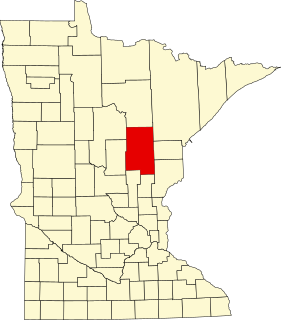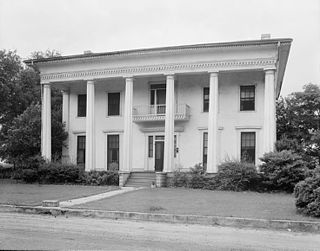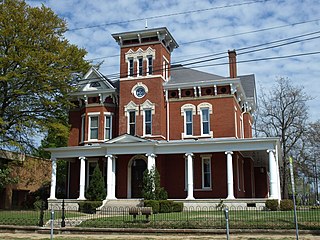
This is a list of the National Register of Historic Places listings in Aitkin County, Minnesota.

The Bray-Barron House is a historic house in Eufaula, Alabama, U.S.. It was built prior to 1850 for Nathan Bray, who went on to serve in the Confederate States Army during the American Civil War of 1861-1865 alongside his three brothers. The house remained in the family until 1963. It was purchased by N. G. Barron and his wife Ruby Hutton Barron in 1965. It has been listed on the National Register of Historic Places since May 27, 1971.

Carson Place, also known as the Cox-Mayfield-Sutley House, is a historic mansion in Tuscaloosa, Alabama, U.S..

The Guild-Verner House is a historic mansion in Tuscaloosa, Alabama, U.S..

The Street House is a historic cottage in Point Clear, Alabama, U.S.. It was built in 1906 for William Street. The house has remained in the family; by the 1980s, it belonged to H. Vaughn Street III. It has been listed on the National Register of Historic Places since December 20, 1988.

The Dr. C.A. Thigpen House is a historic mansion in Montgomery, Alabama, U.S.. It was built for Dr. Charles A. Thigpen, a physician, circa 1898. It was designed in the classical style by architect Frank Lockwood. It has been listed on the National Register of Historic Places since December 13, 1977.

The Tyson–Maner House is a historic mansion in Montgomery, Alabama, U.S.. It was built in 1890 for Archibald Pitt Tyson, a former farmer turned real estate developer. It remained in the family until 1930, as it was inherited by his wife Ellen Nicholson Arrington in 1918 and later by their children. By the 1970s, it belonged to Carl Herbert Lancaster, an architect. It has been listed on the National Register of Historic Places since May 10, 1979.

The Winter Building is a historic building in Montgomery, Alabama, U.S..

The Steiner–Lobman and Teague Hardware Buildings are historic buildings in Montgomery, Alabama, U.S.. They were built by businessmen Louis Steiner and Nathan Lobman circa 1891 for their hardware store. By 1895, the Southern building was sold to William Martin Teague, the owner of the Teague Hardware Company. The buildings remained in the respective families as late as the 1970s. They have been listed on the National Register of Historic Places since January 31, 1979.

The Pepperman House is a historic house located at 17 Mildred Street in Montgomery, Alabama.

The Bass-Perry House is a historic house on a former plantation in Seale, Alabama, U.S.

The Samuel R. Pitts Plantation, also known as the Greenwood Plantation or the William J. Benton House, is a historic house on a plantation in Pittsview, Alabama, U.S..

The Brooks-Hughes House is a historic house in Phenix City, Alabama, U.S.. It was built from 1897 to 1904 as a cottage for W. T. Hall. It has been listed on the National Register of Historic Places since November 3, 1983.

The Miller-Martin Town House is a historic house in Clayton, Alabama, U.S.. It was built as a townhouse for John H. Miller in 1859, and it was designed in the Gothic Revival architectural style. In 1871, it was purchased by Judge Henry Clinton Russell, who served on Barbour County's probate court. In 1915, it was purchased by John Council Martin, who went on to serve as the mayor of Clayton from 1926 to 1930. It was later inherited by his daughter. It has been listed on the National Register of Historic Places since December 16, 1974.

The Joel Hurt House is a historic house in Hurtsboro, Alabama, U.S.. It was built in 1857-1858 for Joel Hurt, his wife Lucy and three sons. During the American Civil War of 1861-1865, the three sons served in the Confederate States Army, and one of them was killed in combat. After the war, Lucy's sister and her husband, Edward Norphlet Brown, who also served as the first mayor of Hurtsboro, lived in the house. In 1900, it was acquired by his son-in-law, Dr. Walter B. Hendrick, who lived there with his wife Margaret until his death in 1941; she went on to live in the house until her death in 1968. It was inherited by their daughter Kate, who lived there until her death in 1997. It has been listed on the National Register of Historic Places since August 11, 2005.

The Lowenstein House is a historic house in Memphis, Tennessee, U.S.. It was built circa 1890 for Elias Lowenstein, a German-born merchant. During World War I, it was used as a boarding house for women who worked. In the first half of the 1920s, Lowenstein's daughter, Celia Lowenstein Samelson, donated the house to The Nineteenth Century Club. It has been listed on the National Register of Historic Places since March 23, 1979.

The Boyce-Gregg House is a historic house in Memphis, Tennessee, U.S..

Arnold-Harrell House is a historic house in Murfreesboro, Tennessee, U.S..
Henry Gibel was a Swiss-born American architect. He designed many buildings in Tennessee, some of which are listed on the National Register of Historic Places.






















